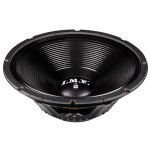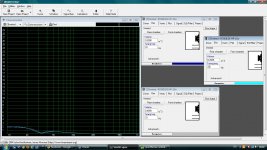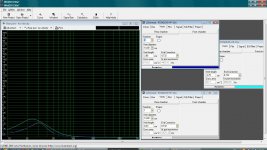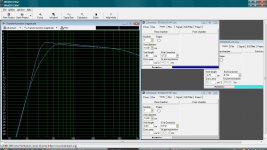Hey guys
I'm am pretty new to the hole speaker science. I am currently making a system to a festival. The sound will be provided by two p.Audio Hp-15w http://www.discopro.ro/files/HP-15W-12S.pdf and two tweeters. My amplifier is a Ta2020 to save power.
The next move is building the box. I want to try a vented box.
My questions are following-
When using two vents, where on the box should they be placed?
What tuning frequence should the box be? (considering we are playing outside)
How to decide how many vents?
Your help is much needed and I thank you in advance 🙂
From Virumflame - Simon
I'm am pretty new to the hole speaker science. I am currently making a system to a festival. The sound will be provided by two p.Audio Hp-15w http://www.discopro.ro/files/HP-15W-12S.pdf and two tweeters. My amplifier is a Ta2020 to save power.
The next move is building the box. I want to try a vented box.
My questions are following-
When using two vents, where on the box should they be placed?
What tuning frequence should the box be? (considering we are playing outside)
How to decide how many vents?
Your help is much needed and I thank you in advance 🙂
From Virumflame - Simon
Hi,
Front & anywhere you like. But why 2 ?
It depends on the volume of the box & how low you want/need to go & how much power you feed them with & what kind of music you will be playing.
Sometimes people can only get certain size tubes/pipes etc, so they use 2 smaller ones. One bigger is best. The larger the diameter the longer they will be, compared to a smaller diameter @ the same tuning frequency.
It would be better if you experimented with something like WinISD. Here's a thread i made which should help 😉 http://www.diyaudio.com/forums/subwoofers/148729-how-correctly-use-winisd.html
When using two vents, where on the box should they be placed?
Front & anywhere you like. But why 2 ?
What tuning frequence should the box be? (considering we are playing outside)
It depends on the volume of the box & how low you want/need to go & how much power you feed them with & what kind of music you will be playing.
How to decide how many vents?
Sometimes people can only get certain size tubes/pipes etc, so they use 2 smaller ones. One bigger is best. The larger the diameter the longer they will be, compared to a smaller diameter @ the same tuning frequency.
It would be better if you experimented with something like WinISD. Here's a thread i made which should help 😉 http://www.diyaudio.com/forums/subwoofers/148729-how-correctly-use-winisd.html
unless for some weird reason, you absolutely need "multiple" vents, use one single larger one. The cross-sectional area is determined by viewing the vent air velocity graph and noting the peak velocity. Ideally, you want to stay below 5% the speed of sound if at all possible. Flaring the ends of the ports helps out.
Model your particular driver with WinISD or any other suitable simulation program and play around with port tuning frequency. See which one gets you the frequency response graph that you are looking for.
Model your particular driver with WinISD or any other suitable simulation program and play around with port tuning frequency. See which one gets you the frequency response graph that you are looking for.
After running some quick calculations, this driver(Assuming it is the one pictured here) really doesn't "need" to be a ported type. The Efficiency Bandwidth Product is at 48.863...... it kinda splits the difference between ported or sealed. Being as it has a rather limited Xmax, or cone travel limits, it is best suited to a sealed enclosure. I calculated an eight cubic foot box for each driver will work fine.......Getting you a Qtc a tad over .8 A very small boomy effect but it will keep the cone "in check" when frequencies go way down.
_________________________________________________Rick.........
_________________________________________________Rick.........
Attachments
1. How many people are expected to be at this festival?
2. Why did you choose that specific 15" driver?
3. What will be using to provide power to these speakers?
2. Why did you choose that specific 15" driver?
3. What will be using to provide power to these speakers?
I'ts a huge festival called Roskilde. The reason why I would like to build a vented box is because we would like a feel that boom everytime the bass drops. But I don't know anything about tuning frequensy and what our tuning frequency should be. Any suggestions ?
I have tried both WinISD beta and alpha, but I can't determine what tuning I should set it to.
I thank you for the advice on the vents by the way🙂
My main question is tuning frequency?
By the way Richard Ellis driver is the one I linked🙂
Brian Steelse - We are using a car battery to power a Lepai Ta2020 wired to two of the before mentioned driver. This is only a part of our setup but needless to say a vital part
I have tried both WinISD beta and alpha, but I can't determine what tuning I should set it to.
I thank you for the advice on the vents by the way🙂
My main question is tuning frequency?
By the way Richard Ellis driver is the one I linked🙂
Brian Steelse - We are using a car battery to power a Lepai Ta2020 wired to two of the before mentioned driver. This is only a part of our setup but needless to say a vital part
you need to simultaneously look at the normalized frequency response, cone excursion, and vent air velocity while you vary the enclosure volume and tuning frequency. If you want a flat frequency response, then adjust the volume and tuning to do so, if you want a to sacrifice some low-end for a higher bump at a single frequency do the same, if you want an extended bass response at the expense of some dBs, then do the same.
Lets see screenshots of what you have come up with so far.
Lets see screenshots of what you have come up with so far.
I have tried WinISD for some time. I understand how the size, tuning and port affects each other. So there is no confusion the third is my driver https://www.intertechnik.de/Shop/La...70?PHPSESSID=36c4ae8c65d7dc1c75e32960513efd13 .
I set the tuning frequens to 33 and the pictures is only 1 driver in a box.
My question are following -
1. What is cone excursion and transfer function magnitude exactly? (attachhed pictures)
2. Why is the only possibility a rear port? What about a front port?
3. Where should the driver be placed when a tweeter will be in the box as well?
4. Does WinISD subtract the volume of the port in the box?
Once again thank you🙂
I set the tuning frequens to 33 and the pictures is only 1 driver in a box.
My question are following -
1. What is cone excursion and transfer function magnitude exactly? (attachhed pictures)
2. Why is the only possibility a rear port? What about a front port?
3. Where should the driver be placed when a tweeter will be in the box as well?
4. Does WinISD subtract the volume of the port in the box?
Once again thank you🙂
Attachments
Hi VF, it's good to be want to build your own cabinets BUT. If you're pushing them with 12 volt powered amps, you're not going to get chest pounding bass. It takes lots of watts to do that in a live sound situation. By the time you spend money on wood, speakers, finish, wire, jack plates, etc. and ending up with a marginal cabinet that won't do what you want, you could buy a couple of efficient commercial subs that will make you happy. I've used and built a lot of subs and I recommend a Yamaha SW218V or CW218V. Same speaker, just different finishes. They're real cheap for the output, especially if you can find a used pair.
1. Cone excursion is the distance (one way) that the cone travels from it's resting position. Xmax is the maximum linear excursion the speaker is capable of, more power over Xmax makes more distortion, but not much more "good" bass.1. What is cone excursion and transfer function magnitude exactly? (attachhed pictures)
2. Why is the only possibility a rear port? What about a front port?
3. Where should the driver be placed when a tweeter will be in the box as well?
4. Does WinISD subtract the volume of the port in the box?
Once again thank you🙂
"Transfer function" is the same as frequency response, how loud at a given frequency.
2. A port can be put on any side of the cabinet.
3. The tweeter in general should be as close to the woofer as possible.
4. Net volume does not include driver, port, or bracing volume.
5. A car battery's life will be short if used for power without an alternator.
They are designed to give up power quickly, then be immediately brought back to 12.6 volts.
Marine batteries are designed for deeper discharge, they have heavier plates.
... we would like a feel that boom everytime the bass drops.
Just to set some realistic expectations here, with a 20 watt amp playing an outside festival your chances of feeling anything are zero percent. Even if you sit on the box you won't feel much of anything. You'll be lucky if it's even loud enough to hear clearly over the noise of the crowd. And it's going to get worse as the battery wears down.
Also, it's very hard to design a good passive crossover if you've never done it before, and crossing a 15 inch driver to a tweeter is an extra challenge that most pros wouldn't even consider trying.
So you've got a lot of work ahead. Good luck.
Just to set some realistic expectations here, with a 20 watt amp playing an outside festival your chances of feeling anything are zero percent. Even if you sit on the box you won't feel much of anything. You'll be lucky if it's even loud enough to hear clearly over the noise of the crowd. And it's going to get worse as the battery wears down.
Also, it's very hard to design a good passive crossover if you've never done it before, and crossing a 15 inch driver to a tweeter is an extra challenge that most pros wouldn't even consider trying.
So you've got a lot of work ahead. Good luck.
I totally missed this about the fisher price/tonka amplifier, LOL. I totally agree with the above statement. You'd feel things more if you pounded your fists on a large empty cardboard box. 😀
Get a generator. I have experience with this kind of thing. You can find cheap ones from China online for $200 that will do 1800W continuous power through awful torture if you look hard enough and be smart about what you're buying. That's enough to actually run a sound system since amplifiers' actual power requirements are not as high as their rated output due to magic in their power supplies.
Without that, you're better off just opening your car doors and turning up the radio.
Without that, you're better off just opening your car doors and turning up the radio.
if you have only 20 watts,i would consider something like the ss15 th.
just don't know if it works for that driver.
just don't know if it works for that driver.
if you have only 20 watts,i would consider something like the ss15 th.
just don't know if it works for that driver.
He wants to make a 2 way with an unspecified tweeter so an ss15 isn't going to work even if it's a huge horn loaded tweeter (which I suspect it's not).
its not going to work properly anyway.
show me a 15"driver with proper extension to 2~3 khz....
me thinks he wants to get as loud as posible,don't think quallity is the goal here 🙂
show me a 15"driver with proper extension to 2~3 khz....
me thinks he wants to get as loud as posible,don't think quallity is the goal here 🙂
Right, but he's looking to waste a bunch of money on lead acid batteries that can't possibly power even a modest system when gasoline generators cost so little. First, get a proper power supply, then build speakers.
its not going to work properly anyway.
show me a 15"driver with proper extension to 2~3 khz....
me thinks he wants to get as loud as posible,don't think quallity is the goal here 🙂
There's a bunch of pro 15's that will get up there. I don't know how "proper" it is to do so but it's possible. The bigger problem is one of dispersion, necessitating a horn (or waveguide) for the tweeter. But if you are using a waveguide you might as well get one that allows a 1khz crossover, they don't cost much.
Plastic SEOS DIY Sound Group
I'm not sure what is available in the OP's location for a reasonable price but I'd suggest a kit of some kind since (as you mention) it's not going to work properly anyway.
But using a bass horn (like the ss15) with a conventional tweeter has absolutely no chance of even being listenable. The bass horn would be a nice touch if it was added to what he is already planning (with it's own amp and active crossover), but not as a replacement for what he is planning.
Anyway, I think he IS hoping for quality - he just doesn't realize yet that it's impossible to achieve with what he is planning.
Right, but he's looking to waste a bunch of money on lead acid batteries that can't possibly power even a modest system when gasoline generators cost so little. First, get a proper power supply, then build speakers.
A quick search (less than 2 minutes) and I found a couple available under $200 (in my country) but I'm going to assume that this is going to double the proposed budget. (I'm assuming he isn't going to buy batteries, but use one that is already available.)
Regardless, the cheapest generator on the market probably isn't a good idea, it might even destroy the amp(s) since that's really not what it's made for. Also, generators are very noisy, the cheapest of them are probably incredibly noisy, and I'm not sure that raising the noise floor is the right direction to go.
If it were me I'd be looking for somewhere to plug in. If it's not possible to plug in I'd be looking into a couple of different situations, both of which use 12 volt systems.
1. Borrow a battery bank from someone that has a solar system and/or
2. Run it directly off a car.
#1 will be hard or impossible (it's not likely that anyone would let their battery bank go for the day or weekend) and #2 would use a lot more gas than a small generator but it would be very quiet in comparison and probably have much more stable power output.
Audio systems that need to play loud outdoors without plugging into a socket connected to the electrical grid are not easy or inexpensive, this is going to be a challenge for sure.
- Status
- Not open for further replies.
- Home
- Loudspeakers
- Subwoofers
- Confused help needed



